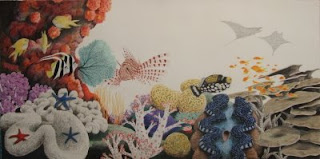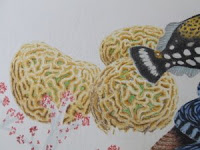
Wow, I can't believe it, but all the coral and fish are done! In this step I have added three new species: plate coral (
Montipora sp.), staghorn coral (
Acropora cervicornis), and silhouettes of two manta rays (
Manta birostris).

Plate corals are called that because they look like plates (I love how so many corals have such easy names). Some grow so large that they are called table coral. They grow flat to maximize their exposure to sunlight, which aids the symbiotic algae within them. The polyps eat zooplankton in addition to using energy from the algae. The color of plate coral is usually dull, though there are a few colorful species. For these, I used light umber, dark brown, French gray 10%, and olive green, with black for shadows.
Staghorn coral look like deer antlers. Their branches provide protection for many tiny fish. These coral are highly susceptible to changes in their habitats, and will often expel the algae as a stress response. The result is a white coral, called
bleached, that is a clear sign of an unhealthy or dying area of a reef. Because these corals in particular are so prone to stress and bleaching, they are highly endangered. I used three shades of French gray to create these corals.
Manta rays are the largest rays. They are filter feeders, feeding mainly on plankton and other tiny organisms, but it is interesting to note that they still retain vestigial teeth. A thick layer of mucous on their skin protects it from injury. Sharks are their main predator. Since the rays here are just silhouettes in the distance, I covered them lightly with black for now. I'll finish them when the water goes in.
So I guess that's it. I'm going to put this aside for a bit while I decide what to do with the water. I have a couple charcoal drawings I've been thinking about lately anyway. So probably the next time you see a post on the reef, it'll be finished!
References:
http://www.poppe-images.com/http://en.wikipedia.org/wiki/Montiporahttp://en.wikipedia.org/wiki/Staghorn_coralhttp://en.wikipedia.org/wiki/Manta_Ray
 A few months ago I discovered an amazing new product from Derwent. They have taken charcoal and mixed it with various clays to produce tinted charcoal. I've tested them out on drawing paper to show the different colors. Most of the colors are very subtle greens, browns and blues.
A few months ago I discovered an amazing new product from Derwent. They have taken charcoal and mixed it with various clays to produce tinted charcoal. I've tested them out on drawing paper to show the different colors. Most of the colors are very subtle greens, browns and blues.








